Garage ceiling ideas
Have you been searching for affordable ways to upgrade your garage ceiling without straining your budget? Have you ever wanted to enhance the functionality and style of your garage while keeping the costs low?
We have successfully explored and experienced a variety of budget-friendly ideas that can completely revamp your garage into a more inviting and practical area. Through DIY projects and simple upgrades, we have witnessed remarkable transformations.
In our journey, we have come to realize the significance of the garage ceiling in home improvement ventures. Although often overlooked, it plays a vital role in both the visual appeal and functionality of the garage.
By implementing a range of cost-effective garage ceiling ideas, we have been able to completely revitalize our garage ceiling, elevating it to new levels of functionality and style. The unattractive or damaged ceiling that once posed safety risks is now a thing of the past.
With these tried-and-tested inexpensive garage ceiling ideas, we have successfully created a space that seamlessly combines functionality and aesthetics, making our garage a more enjoyable and visually appealing environment.
You may also like:
What is a Garage Ceiling?
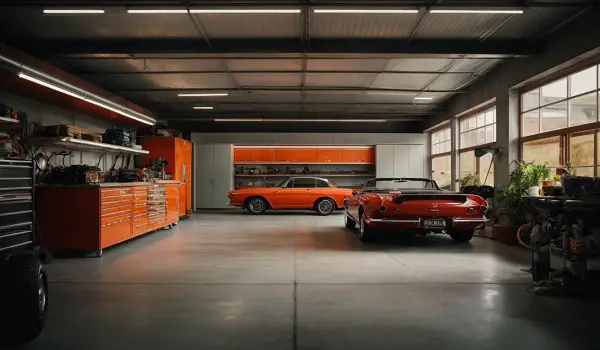
A garage ceiling refers to the overhead surface or structure that covers and encloses the interior space of a garage.
It is typically made of materials such as drywall, plaster, or plywood, and may include insulation or other features to help regulate the temperature and acoustics of the garage.
The ceiling may also be equipped with lighting fixtures, ventilation systems, or storage racks to maximize the functionality and efficiency of the garage.
Why is the Garage Ceiling Important?
Before we dive into the different ideas for garage ceilings, it’s important to understand why it’s a crucial part of your garage. The garage ceiling can serve many purposes, including:
- Hiding wires and pipes for a neater and safer space
- Providing insulation to maintain the temperature in the garage
- Adding storage space for items that are not used frequently
- Enhancing the overall look and feel of the garage
Now that we understand the importance of the garage ceiling, let’s explore some creative ideas to improve it. Let’s get into 18 unique yet cheap garage ceiling ideas that will make your garage look like a dream space.
Read Also: Inexpensive Porch Ceiling Ideas
18 Inexpensive Garage Ceiling Ideas
Idea#1. Aluminum Soffit Ceiling

An aluminum soffit is a building material used for covering the underside of a roof’s overhang. It is typically made of aluminum and comes in a variety of colors and finishes to match the exterior of a building.
Features
- Durable: The aluminum soffit is resistant to rust and corrosion, making it a long-lasting option for homes and commercial buildings. Low-maintenance: Unlike wood or other materials, aluminum soffit does not require regular painting or staining.
- Ventilation: Aluminum soffit panels are designed to provide ventilation to the attic, which helps to prevent moisture buildup and mold growth.
- Aesthetic appeal: The wide range of colors and finishes available for aluminum soffits can enhance the exterior of a building and improve its curb appeal.
Pros
- Long-lasting: The aluminum soffit is a durable material that can last for many years without the need for repairs or replacement.
- Low-maintenance: Its low-maintenance nature means that it saves both time and money in the long run.
- Aesthetically pleasing: The variety of colors and finishes available for aluminum soffits can complement any architectural style and enhance the overall look of a building.
- Ventilation: The ventilation provided by the aluminum soffit can help to prevent moisture buildup and mold growth in the attic, promoting a healthier living environment.
Cons
- Higher cost: Aluminum soffit is typically more expensive than other materials such as vinyl or wood.
- Professional installation required: Installing an aluminum soffit requires expertise, and it is best done by professionals.
Aluminum soffit is a great option for homeowners and commercial building owners who want a durable and low-maintenance material that can enhance the look of their property.
While it may be more expensive than other materials, its long-lasting nature and aesthetic appeal make it a worthwhile investment.
Additionally, its ability to provide ventilation to the attic can promote a healthy living environment. However, it is essential to have it professionally installed to ensure proper installation and maximize its benefits.
Idea#2. Bare Rafters Ceiling
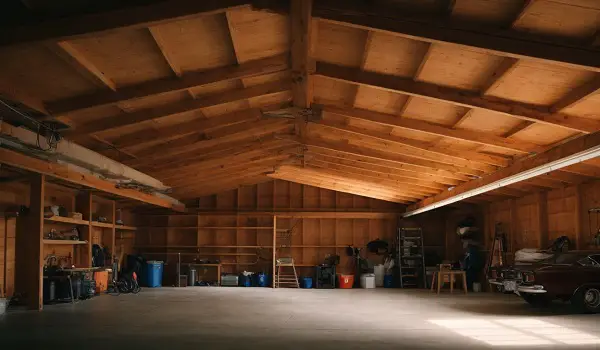
Bare Rafters is a new type of roofing material that provides a unique, natural look for your home. Made from untreated, bare wood, these rafters have a rustic appearance that is perfect for those who want to bring the outdoors inside.
Bare Rafters are easy to install and provide excellent insulation, keeping your home cool in the summer and warm in the winter.
Features
- Made from untreated, bare wood
- Rustic appearance for a natural look
- Easy to install
- Excellent insulation properties
Pros
- Provides a unique and natural look for your home
- Easy to install, reducing labor costs
- Good insulation properties can help reduce energy bills
- Made from sustainable materials, making it an eco-friendly choice
Cons
- Untreated wood may be susceptible to rot and decay over time
- May require more maintenance than other roofing materials
- May not be suitable for all types of homes or architectural styles
Bare Rafter is an excellent choice for those who want to add a natural and rustic look to their home. While it may require more maintenance than other materials, the unique appearance and insulation properties make it a worthwhile investment.
It is important to consider the suitability of this material for your specific home and climate conditions before making a decision.
Idea#3. Beadboard Porch Ceiling
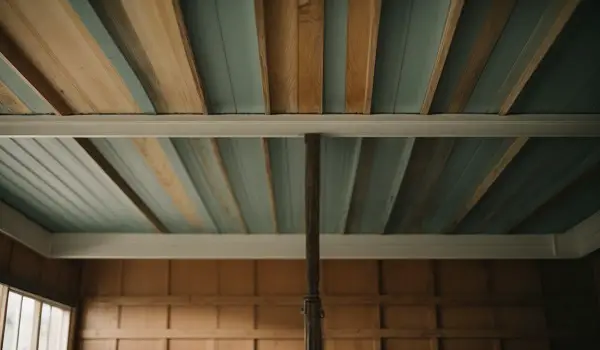
Beadboard Porch is a type of porch ceiling that features narrow, tongue-and-groove planks with a bead along the edge of each board.
This classic and timeless design has been a popular choice for outdoor living spaces for generations. It is made from wood, PVC, or composite materials, and is available in a range of finishes to match any architectural style.
Features
- Narrow, tongue-and-groove planks with a bead along the edge of each board.
- Classic and timeless design.
- Available in wood, PVC, or composite materials.
- Range of finishes to match any architectural style.
Pros
- Beadboard Porch has a traditional look that adds charm and character to any porch.
- It is durable and long-lasting and can withstand harsh weather conditions.
- It is available in a variety of materials and finishes, making it a versatile choice for any home.
- It is easy to install, making it a great DIY project.
Cons
- Beadboard Porch requires regular maintenance to keep it looking its best.
- It can be expensive, especially if you choose high-quality materials.
- Depending on the material used, it may be susceptible to moisture damage over time.
Beadboard Porch is a beautiful and timeless choice for any porch ceiling. While it may require regular maintenance and can be expensive, its durability and versatility make it a great investment for any homeowner looking to add charm and character to their outdoor living space.
Idea#4. Cork Ceiling

Cork is a versatile and sustainable material that is harvested from the bark of cork oak trees. It has a unique cellular structure that makes it lightweight and compressible while also being durable and resistant to moisture and rot.
Cork is commonly used as a flooring material, as well as in the production of wine bottle stoppers, bulletin boards, and various other consumer products.
Features
- Lightweight and compressible
- Durable and resistant to moisture and rot
- Versatile and sustainable material
- Renewable resource
- Easy to maintain
- Good insulation properties
Pros
- Cork is a renewable resource and environmentally friendly.
- It is resistant to moisture and rot, making it ideal for use in areas with high humidity or moisture.
- Cork is easy to maintain, requiring only occasional cleaning.
- Its good insulation properties make it an energy-efficient material.
- Cork is versatile and can be used in a variety of products, from flooring to wine bottle stoppers.
Cons
- Cork can be expensive compared to other flooring materials.
- It may require periodic resealing to maintain its water resistance.
- It may not be as durable as some other flooring materials, particularly in high-traffic areas.
Cork is a sustainable and versatile material that offers a range of benefits, including good insulation, moisture resistance, and easy maintenance.
While it may be more expensive than some other materials, its environmental benefits and versatility make it an attractive option for many consumers.
Its durability may be a concern in high-traffic areas, and it may require periodic resealing to maintain its water resistance.
Idea#5. Drywall Ceiling
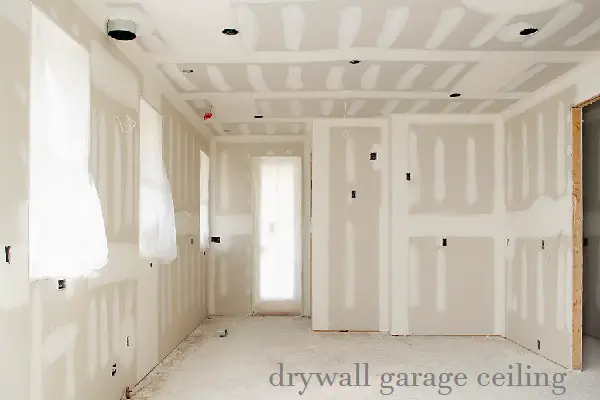
Drywall, also known as gypsum board or plasterboard, is a type of construction material made from gypsum plaster that is sandwiched between two thick sheets of paper or fiberglass mats.
It is commonly used to create interior walls and ceilings in residential and commercial buildings.
Features
- Lightweight and easy to install
- Can be easily cut to fit around obstacles like doors and windows
- Provides a smooth surface for painting or wallpapering
- Resistant to fire, mold, and moisture
Pros
- Quick and easy to install, reducing labor costs
- Provides a clean and smooth finish to walls and ceilings
- Resistant to fire, which can improve the safety of a building
- Can help reduce noise transmission between rooms
- Relatively inexpensive compared to other wall and ceiling materials
Cons
- Susceptible to damage from impact or moisture, which can lead to cracks or mold growth
- Requires skill to properly install and finish
- Limited design options, as drywall is typically a flat and uniform surface
- Not as durable as some other wall materials, such as brick or stone
Drywall is a versatile and cost-effective material for creating interior walls and ceilings in buildings. While it has some drawbacks, such as susceptibility to damage, it offers many benefits such as easy installation and a smooth finish. Overall, it remains a popular choice for construction projects due to its affordability and ease of use.
Idea#6. Gypsum Ceiling
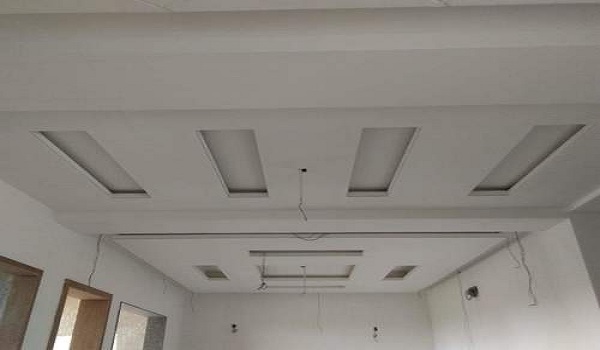
Gypsum is a soft sulfate mineral composed of calcium sulfate dihydrate. It is widely used in construction as a material for plastering, wallboard, and cement.
The mineral is found in sedimentary rocks and is often formed as a result of the evaporation of shallow seas.
Features
- Soft and easy to carve or shape
- Fire-resistant and does not emit harmful gases when heated
- Good soundproofing and insulation properties
- Can be used as a soil conditioner to improve soil quality
- Non-toxic and safe for human use
Pros
- Gypsum is a versatile material that can be used for a wide range of applications in construction and agriculture.
- It is a cost-effective material that is widely available.
- Gypsum is easy to work with and can be shaped to fit any design or purpose.
- It is a non-toxic and safe material that can be used in areas where human contact is likely.
Cons
- Gypsum is a relatively soft material and may not be suitable for high-traffic areas or heavy use.
- It may not be as strong or durable as other construction materials.
- Gypsum may be prone to cracking or warping if not properly installed or maintained.
Idea#7. Lowered Ceiling

A lowered ceiling is a popular choice for garages because it makes the space feel more intimate. It also helps to insulate the garage, keeping it warmer in winter and cooler in summer.
A lowered ceiling can provide extra headroom for cars or other tall items that need to be stored in the garage. To install a lowered ceiling, you’ll need to remove the existing drywall or plaster and then cut and attach new framing material to the joists.
Best Features
Lowering the ceiling can be a practical and cost-effective solution, especially if the existing ceiling is in poor condition. It allows you to conceal imperfections and create a cleaner look.
Pros
- Conceals existing ceiling issues
- Provides an opportunity for improved insulation
Cons
- Reduces overhead space, which may be a concern for taller individuals
Idea#8. Metal Ceiling Tile
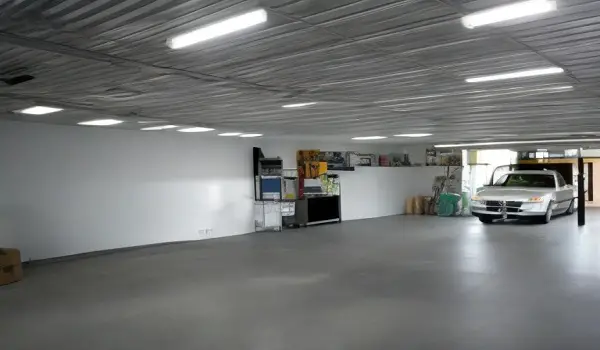
Metal ceiling tiles are affordable, corrosion-resistance, and durable options for garage ceilings. They can be used to create a modern or industrial look in your garage. Metal ceiling tiles are available in a variety of colors and patterns, allowing for easy customization options.
As the material is light and strong, it can be used to decorate the ceiling of garages, sheds, and other structures. They also make great surfaces for creating designs using metal grilles and fabric or paper stencils.
Their durability makes them suitable for use in all seasons without compromising on appearance. Besides, they are easy to install and require minimal maintenance. Overall, metal ceiling tiles are a cost-effective and versatile option for garage ceilings.
Best Features
Metal ceiling tiles can be an excellent choice for a contemporary and industrial look. They are durable, easy to clean, and can add a touch of sophistication to your garage.
Pros
- Durable and long-lasting
- Modern and stylish appearance
- Easy to maintain and clean
Cons
- Slightly more expensive than some other options
Idea#9. Oriented Strand Board (OSB) Ceiling
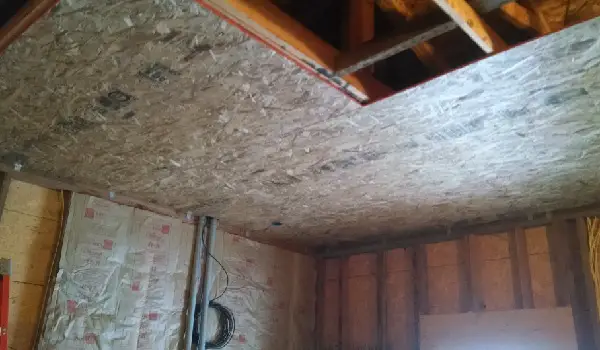
Oriented strand board (OSB) is a popular material for use in garage ceiling DIYs. It’s made of strands of wood that are formed together with resins and waxes.
This material is cheaper than plywood, making it an ideal budget option for those on a limited budget.
It’s durable and water-resistant, making it great for garage ceiling DIYs in environments like garages.
To install OSB, you’ll need some skill and experience, so it’s best to hire a professional to do the job if you aren’t confident in your abilities.
Besides, OSB has a bright white appearance, which makes it easy to spot and clean. Also, this material is easily bendable, which makes it durable and easy to install.
That said, if you’re looking to save money on garage ceiling ideas, OSB is a good choice!
Best Features
Oriented Strand Board (OSB) is an affordable alternative to plywood. It offers a wood-grain texture and can be easily painted or stained to match your garage decor.
Pros
- Cost-effective substitute for plywood
- Textured appearance
- Can be painted or stained
Cons
- Not as aesthetically appealing as some other materials
Idea#10. Plywood Ceiling
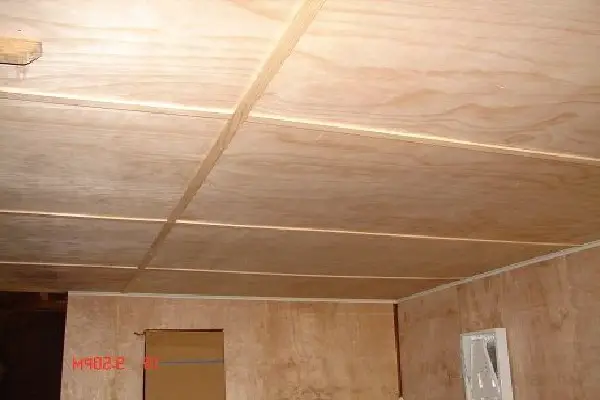
Plywood is one of the most affordable materials for garage ceiling ideas. Plywood is a type of wood that is most commonly used to make boards and panels for building structures.
When used in garage ceiling ideas, plywood can be used in a variety of ways, such as for shelving or storage solutions.
Best Features
Plywood is a versatile and inexpensive choice for garage ceilings. It provides a smooth and even surface, suitable for various finishes.
Pros
- Versatile and easy to work with
- Smooth surface for painting or staining
- Affordable and widely available
Cons
- May not offer as unique an appearance as other materials
Idea#11. Popcorn Ceiling
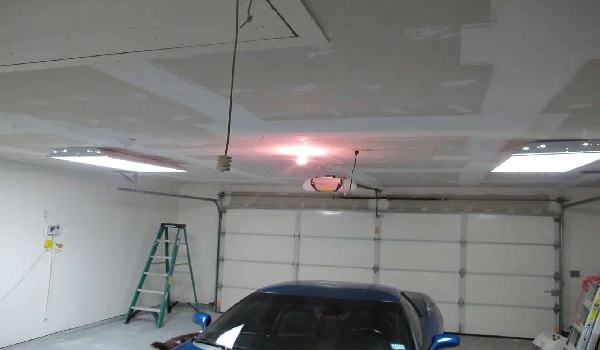
Popcorn ceilings are an inexpensive way to add texture and interest to a room. Popcorn ceilings were popular in the 1970s and 1980s, but have fallen out of favor in recent years.
They are made by spraying a textured material onto the ceiling, which creates a “popcorn” effect.
Popcorn ceilings can be painted any color you like, making them versatile for any space. They are also easy to clean and maintain, making them ideal for busy households.
Best Features
Popcorn ceilings, also known as acoustic ceilings, are a cost-effective solution that can add texture to your garage. They are simple to apply and can help dampen sound.
Pros
- Budget-friendly option
- Can help with noise reduction
Cons
- Difficult to clean and maintain due to the textured surface
Idea#12. PVC Tiles Ceiling

PVC tiles are a great option for garages because they’re lightweight, durable, and waterproof. They come in a variety of colors and sizes, making it possible to customize the look of your garage.
This makes them an affordable way to add texture and color while also providing a sound barrier and insulation.
They’re easy to install by clipping them into the ceiling grid and cutting them to size. Finally, PVC tiles are an environmentally friendly way to add texture and color to your garage ceiling.
They’re inexpensive and can be used over and over again, making them a great investment for any garage renovation.
Best Features
PVC ceiling tiles are an inexpensive option that offers a wide range of design choices. They are lightweight, easy to install, and can be found in various patterns and colors.
Pros
- Affordable and lightweight
- Numerous design options available
- Easy to install
Cons
- May not provide the same level of insulation as other materials
Idea#13. Corrugated Metal Ceiling
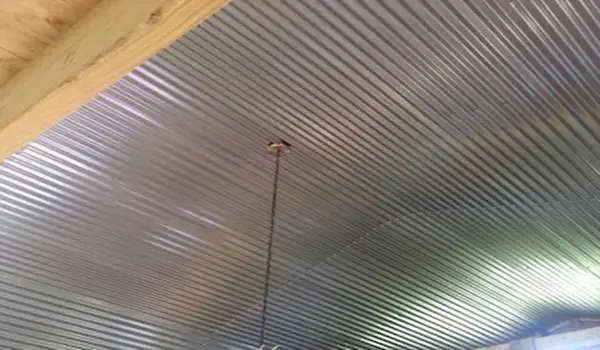
Corrugated metal ceilings are a bold and stylish design choice that can add a touch of industrial garage style, rustic charm, or even a modern touch to any room. Made from sheet metal pressed into a series of waves or ridges, they are available in a variety of materials (steel, aluminum, copper, etc.) and finishes (galvanized, painted, pre-rusted, etc.) to suit any taste or taste. tasting. budget.
Best Features
Corrugated metal ceilings offer a unique blend of style and functionality, making them a popular choice for modern, industrial, and rustic spaces alike.
Pros:
- Durability: Metal is a tough material that can withstand moisture, fire, and pests. It’s also easy to clean and maintain.
- Unique aesthetic: Corrugated metal adds a distinctive visual element to any space. It can be used to create a variety of looks, from industrial to rustic to modern.
- Versatility: Metal can be painted or stained to match your existing décor. It can also be left unfinished for a more industrial look.
- Affordability: Metal is often a more affordable option than other ceiling materials, such as wood or drywall.
Cons:
- Noise: Metal can be noisy, especially if it’s not properly insulated. This can be an issue in rooms where you want to relax or sleep.
- Temperature: Metal can get hot or cold depending on the temperature outside. This can make your room uncomfortable if you’re not careful about insulation.
- Weight: Metal is a heavy material, so it’s important to make sure your ceiling joists can support the weight.
- Installation: Installing a metal ceiling can be more difficult than installing other types of ceilings. It’s usually best to hire a professional to do the job.
Idea#14. Styrofoam Tiles Ceiling
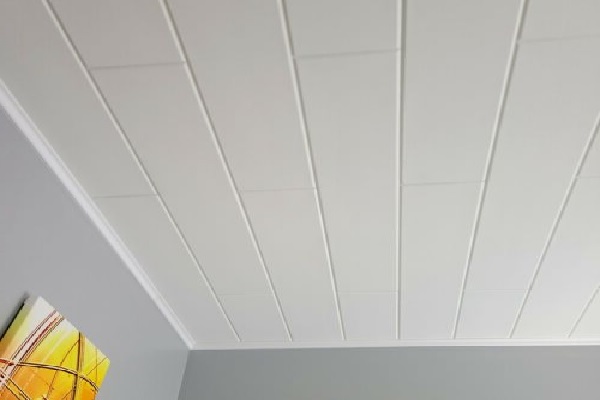
Styrofoam tiles are a cost-effective and environmentally friendly solution for covering a garage ceiling. They’re easy to install and can be painted for a more customized look. The tiles provide good insulation which helps to keep the temperature in the garage comfortable.
They’re available in a variety of colors, textures, and sizes so you can find the perfect fit for your space. Styrofoam tiles are durable and comfortable to walk on, making them an ideal option for flooring garage floors.
They’re an affordable and accessible option that can help give your garage a makeover without breaking the bank.
Best Features
Styrofoam ceiling tiles are a lightweight and affordable option, particularly if you’re aiming for an elegant and decorative look.
Pros
- Lightweight and easy to install
- Available in various designs and patterns
- Budget-friendly
Cons
- Not as durable as some other materials
Idea#15. Tiles or Planks Ceiling
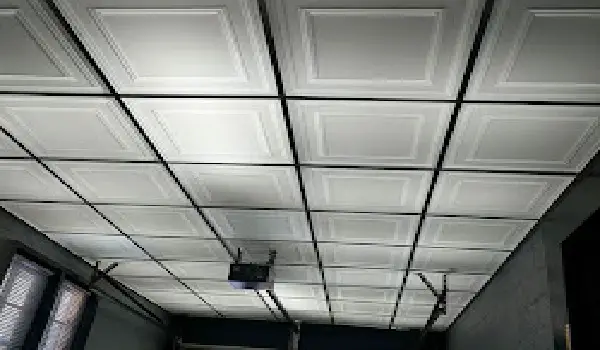
If you want a ceiling in your garage, but don’t want to pay high costs for expensive materials or labor, consider making use of the affordable options available on the market.
You can opt for plastic acoustic ceiling tiles and foam ceiling tiles as they are durable and easy to install.
Another option is wood planks which are cost-effective and can last for years. Spruce up the look of your garage with beaded board panels and plywood sheets, which are budget-friendly and highly durable.
For an alternate material, metal panels or tiles are a good choice as they are lightweight and corrosion-resistant.
You can also go for corrugated steel sheets and vinyl banners as they are flexible, inexpensive, easy to clean, and durable.
The ceiling should be painted before installing any of the above materials so that it doesn’t interfere with insulation. Lastly, make sure to check the specifications of each material before purchasing so that you get the perfect product for your garage ceiling.
Best Features
Ceiling tiles or planks made of materials like fiberboard or MDF (medium-density fiberboard) can be an economical and stylish choice for your garage.
Pros
- Budget-friendly option
- Various designs and finishes available
- Easy to install
Cons
- May not be as durable as other materials
Idea#16. Tin Ceiling Tiles
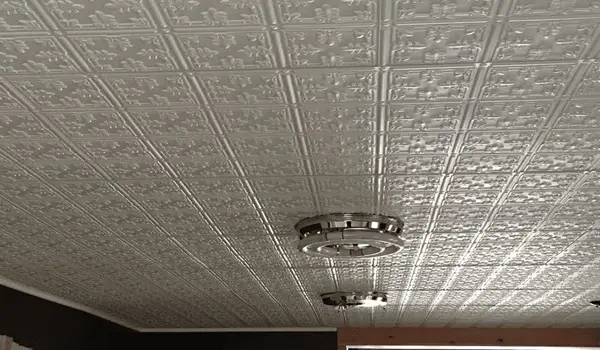
Tin ceiling tiles can be a great way to add a touch of character and style to your garage, whether you’re going for a rustic, industrial, or vintage vibe. Here’s a breakdown of what you need to know:
Pros:
- Durability: Tin is a strong and weather-resistant material that can withstand moisture, temperature changes, and even the occasional bump from tools or equipment.
- Easy to clean: Tin ceiling tiles are easy to wipe down with a damp cloth, making them ideal for dusty or dirty garage environments.
- Variety of styles: Tin ceiling tiles come in a wide variety of designs, from classic patterns like beadboard and floral to more modern geometric shapes. You can also find them in different finishes, such as painted, distressed, or antiqued.
- Relatively affordable: Compared to other ceiling materials like wood or drywall, tin ceiling tiles are a relatively affordable option.
- Improves insulation: Tin tiles can help to insulate your garage, keeping it cooler in the summer and warmer in the winter.
Cons:
- Can be noisy: Tin can be a noisy material, especially if it’s not properly installed or insulated. This can be an issue if you use your garage for loud activities like woodworking or music.
- Installation can be tricky: Installing tin ceiling tiles can be a bit more challenging than installing other types of ceilings. It’s important to make sure the tiles are properly aligned and secured to avoid sagging or warping. You may want to consider hiring a professional for this job.
- Not fire-resistant: Tin is not a fire-resistant material, so it’s important to be aware of this if you store flammable materials in your garage.
Idea#17. Vinyl Beadboard Soffit Ceiling
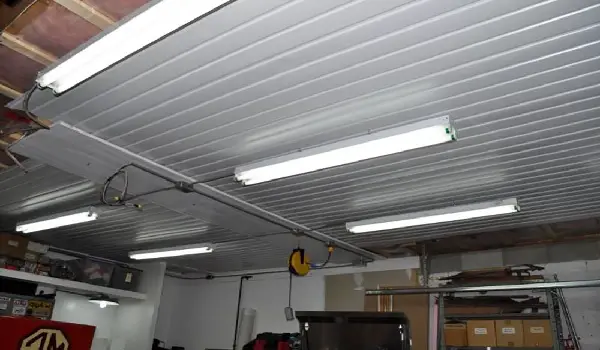
Vinyl beadboard soffit is a cost-effective and decorative way to enhance your garage ceiling. It is available in multiple colors and patterns, making it versatile and easy to use. This material is durable, moisture-resistant, and easy to paint if desired.
This soffit material provides an affordable option for garage remodeling projects, making it an ideal choice for any garage ceiling improvement project. A vinyl beadboard soffit is a cost-effective and stylish option for enhancing your garage ceiling.
Best Features
Vinyl beadboard soffit is a cost-effective and moisture-resistant option for garage ceilings. It offers a classic look that is easy to maintain.
Pros
- Resistant to moisture and humidity
- Low maintenance and long-lasting
- Budget-friendly
Cons
- May not offer the same level of insulation as other materials
Idea#18. Vinyl soffit Ceiling
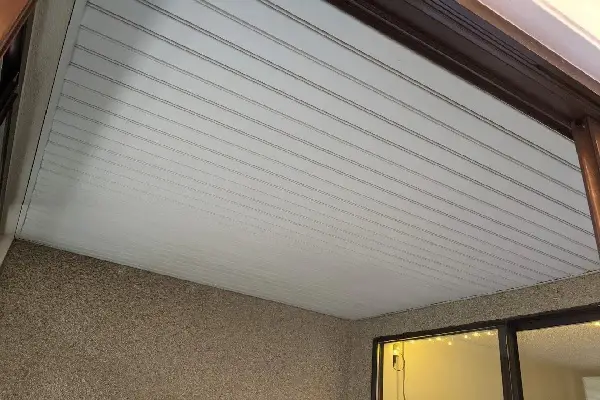
Vinyl soffit is a versatile, durable, and low-maintenance material that can be used for a variety of garage ceiling projects. It’s available in multiple colors, making it easy to find the perfect match for your garage.
The vinyl soffit is also easy to install, making it a great option for anyone looking for an affordable way to update their garage ceiling.
Best Features
The vinyl soffit can be an affordable alternative to other materials. It is easy to clean and maintain, making it suitable for garage ceilings.
Pros
- Easy to clean and maintain
- Budget-friendly option
Cons
- Limited design choices compared to other materials
Cheapest material for Ceiling
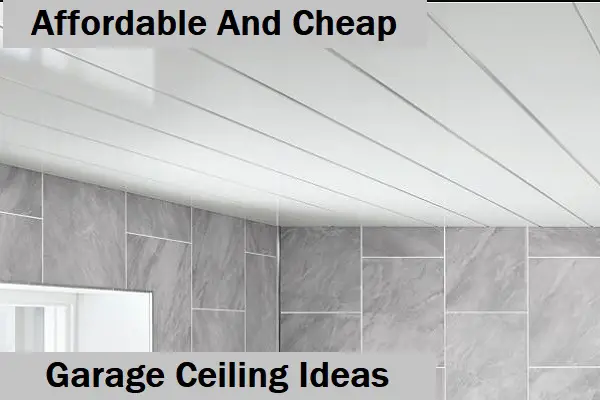
There are several materials that can be used for ceiling construction that are relatively cheapest. Some options include:
- Gypsum board (also known as drywall or sheetrock): This is a common choice for ceiling construction because it is easy to install and finish. It is also relatively inexpensive and lightweight.
- Plywood: Plywood is a strong and durable material that can be used for ceiling construction. It is relatively inexpensive and easy to work with.
- Plaster: Plaster is a traditional material that has been used for centuries to finish ceilings. It is relatively inexpensive and can be molded into a variety of shapes and textures.
- Acoustic tiles: Acoustic tiles are lightweight panels that are often used in offices and other commercial buildings to help improve the acoustics of a space. They are relatively inexpensive and easy to install. Metal panels: Metal panels are another option for ceiling construction. They are durable and easy to maintain but may be more expensive than some of the other materials on this list.
Fiberboard is a type of engineered wood product that is made from wood fibers and adhesives. It is a lightweight and inexpensive material that is often used in construction and furniture-making. There are several types of fiberboard, including:
- Particleboard: Particleboard is made from small wood particles that are held together with a resin binder. It is a relatively inexpensive and lightweight material that is often used in the construction of furniture and as a substrate for countertops and flooring.
- MDF (medium-density fiberboard): MDF is a type of fiberboard that is made from wood fibers that are combined with resin and then pressed together under high pressure. It is a strong and stable material that is often used in the construction of furniture and as a substrate for countertops and flooring.
- Hardboard: Hardboard is a type of fiberboard that is made from wood fibers that are combined with resin and then pressed together under high pressure. It is a dense and smooth material that is often used in the construction of furniture and as a substrate for countertops and flooring.
Fiberboard can be a good choice for ceiling construction in certain situations, such as when you need a lightweight and inexpensive material that is easy to work with.
It may not be as durable or long-lasting as some other materials, such as gypsum board or plywood.
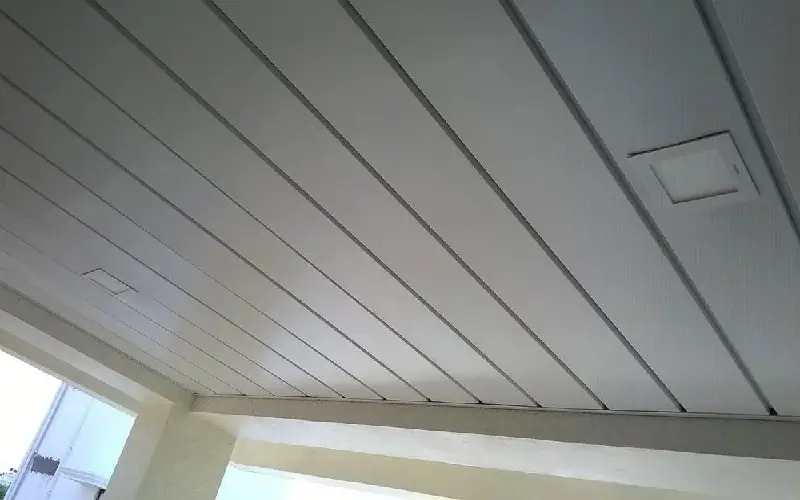
Conclusion
Revamping your garage ceiling on a budget becomes a delightful endeavor with these cost-effective and imaginative garage ceiling ideas.
Embark on a journey of transformation with accessible upgrades, such as a fresh coat of paint or the whimsical addition of string lights. Alternatively, dive into more intricate projects like the installation of a drop ceiling, injecting both style and practicality into your garage without breaking the bank.
Unleash your creativity and channel your inner DIY enthusiast to elevate your garage into a welcoming and efficient space. Let these suggestions be your catalyst for a garage makeover that not only satisfies your aesthetic cravings but also enhances the functionality of this often-overlooked area.
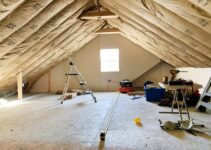
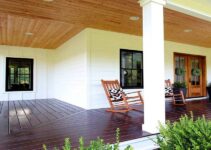
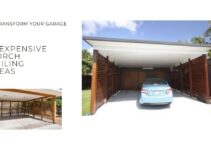
That sounds great! I never realized the importance of the garage ceiling. What role does it play in home improvement?
The garage ceiling plays a vital role in both the visual appeal and functionality of the garage. It contributes to the overall aesthetic of the space and can enhance its practicality. By focusing on the ceiling, you can create a more enjoyable and visually appealing environment.
These ideas sound perfect for my budget and needs. I can’t wait to get started. Thank you for your help!
You’re welcome! We’re glad we could assist you. Best of luck with your garage ceiling upgrade, and we hope it turns out fantastic! If you have any more questions, feel free to ask.
I’ve had some safety concerns with my current ceiling. Can these ideas address that?
Definitely! Our tried-and-tested inexpensive garage ceiling ideas can help eliminate safety risks associated with unattractive or damaged ceilings. You’ll be able to address those concerns and create a safer and more secure garage.
I noticed some water stains on the ceiling of my garage, which makes me think there might be a leak. I’m in the market for a garage ceiling that’s waterproof and aligns with the suggestions you shared.
Considering your worries about water stains on your garage ceiling, it’s important to find a waterproof solution. PVC Ceiling Tiles are a great option—they’re affordable, lightweight, and easy to install. They come in a variety of textures and colors, providing excellent moisture resistance, and are easy to clean.
Additional tips to prevent future leaks:
Regularly inspect your roof and gutters for any signs of damage.
Trim back any tree branches that overhang the roof.
Install a gutter system with downspouts that extend away from the garage foundation.
Consider adding roof vents to improve air circulation and prevent condensation.